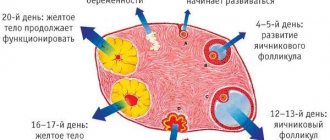The monthly cycle is a natural physiological process that occurs in the body of every woman. Depending on how menstruation goes, how much blood is lost during bleeding and how a woman feels during this period, her women’s health is judged. Therefore, girls of any age should definitely know the indicators of normal menstruation and, if deviations are detected, report this to the gynecologist. This will help her avoid problems with the reproductive system in the future.
How often should periods come?
Physiologically, menstruation means that a girl is ready to continue life: to conceive, bear and give birth to a child.
After the start of menstruation, the constant activity of hormones (progesterone and estradiol) produced by the ovaries is adjusted, and menstrual (ovulatory) cycles are repeated monthly. During them, an egg is born, develops, dies and is removed from the body. Normally, the length of each cycle should be approximately the same length of time, but there are cases when cycles, for various reasons, have failures.
Regularity and duration of menstruation (periods)
Very often, women wonder how long a regular menstrual cycle should last, how many days should menstruation last, and how many days later should menstruation occur. A full menstrual cycle, excluding deviations, lasts 21-35 days, menstruation, as its first stage, lasts from 3 to 8 days. For a healthy body, an error in the onset of menstruation by 1-2 days is considered normal.
Some women face the problem of cycle irregularity, when its duration is constantly changing. This phenomenon is harmless for up to 24 months following the onset of menstruation, due to the fact that during this period the girl’s hormonal background is not yet fully formed and jumps in the level of sex hormones in the blood can affect the nature and duration of menstruation. For adult women with an established regular cycle, such discrepancies may be evidence of pathologies and inflammation or a harbinger of the premenopausal period.
Menstrual flow may be delayed or absent due to pregnancy and lactation, menopause, hormonal imbalance, stress and shock, illnesses and injuries, unhealthy diet and vitamin deficiency, etc.
Calculation methods
The regularity of menstruation in women should be discussed by knowing the exact number of days in the cycle. You should understand what the menstrual cycle is. Some people mistake it for the period between discharges. In reality, a cycle includes the total number of days from the first day of your period to the first day of your next period.
You can calculate the menstrual cycle using the following formula:
(Date of menstruation - date of previous menstruation) + one additional day = cycle duration
Let's give an example: (December 26 – November 30) + 1 day = 28 days.
The norm is 28 days. However, a duration of 21 to 35 days is allowed; these are all normal options.
The duration of the female cycle can be influenced by:
- fatigue and overwork;
- stressful situations;
- diets, weight loss or weight gain;
- colds and exacerbation of chronic diseases;
- moving to a different climate zone, etc.
To keep track of their own cycle, the doctor often recommends that girls keep a calendar and mark the dates of their periods in it. This method will allow you not only to monitor the condition of the body, but also to accurately indicate information to the gynecologist when visiting him.
What is menstruation (periods), what do they mean?
To understand how many days later menstruation occurs, how many days the monthly cycle lasts before the onset of menstruation, you need to understand what menstruation is and how exactly it passes, how it affects different organs of the female body. Menstruation or menstruation comes after a certain number of days. Menstruation is the first phase of a woman's monthly ovulatory cycle. At this time, the body cleanses itself of the unfertilized egg. A small amount of blood containing particles of the uterine lining is also released. With the onset of menstruation, the cycle is reset.
In the first days, menstrual blood does not clot and is colored scarlet, which by the end of the discharge, under the influence of enzymes, becomes darker, even brown.
Menstruation, monthly discharge, should be regular, and its delay or cessation indicates successful conception and pregnancy or disruption of the body.
All periods of the ovulatory cycle, volume of discharge per day, what is the norm?
All periods of the ovulatory cycle are associated with stages of egg development. First, an egg is formed from the follicle in the ovary, the uterus prepares for its fertilization and consolidation, becoming overgrown with a layer of endometrium. By the end of the second week of the cycle (in its middle), the mature egg begins its journey from the ovary, passing into the fallopian tube, through which it is sent to the uterus. When fertilization occurs, it is fixed in the endometrial layer and an embryo develops from it. If there was no conception, the egg, along with the endometrium, dies and exits the body through the vagina, after which the cycle is renewed.
The average volume of discharge per menstruation is 250-260 ml, or 40-60 ml per day. They are most abundant in the first days, then the abundance of discharge decreases. The abundance of menstruation is individual and can vary, based on the presence of chronic diseases, the nature of sexual activity and the use of contraception, the number of pregnancies, physical activity and activity of the woman, nutrition and bad habits.
Menstruation usually appears in the age range from 10 to 16 years (less often - from 8 or 9 years), ends from 45 to 55 years, in more rare cases - several years later. After menstruation stops, menopause begins.
About lost blood
In addition to all the above data, the girl should know approximately how much blood is lost during menstruation. And also know how much she personally loses in order to determine her normal limit.
How much blood is lost during menstruation?
Many representatives of the fair half are sure that the amount of blood lost exceeds all limits. In fact, everything is far from true. Approximately the loss of menstrual fluid during the day is 30-70 ml, the total amount for the entire period of bleeding reaches 250-300 ml, this is about a glass.
This loss does not affect the woman’s condition; she will quickly return to normal.
In appearance, the blood has a bright scarlet color. The precursor to the onset of menstruation can be red-brown spotting. They can also indicate the end of critical days if they appear at the end of red days. All this is not outside the norm.
In addition, pieces of the endometrium may come out along with the bloody fluid, which in appearance resemble clots. How many there are and what their volume depends on the individuality of the organism. You should know that menstrual fluid is not only blood, but also a dead egg, mucus, and the remains of the functional layer of the uterine wall.
Menstrual blood has a specific smell. The closest thing this smell resembles is meat or iron - these are the right smells. All this through a vital microelement found in the secretions - iron. Through it, the specificity of the smell is created.
But don’t worry, it is weakly expressed and difficult for an outsider to smell. And a girl can only feel it when changing hygiene products.
How to determine how much blood is lost per day?
In principle, nothing complicated. You just need to pay attention to the gasket. If several small spots are found on it, this is approximately 3-4 grams of blood. If the hygiene product is changed every 3-4 hours, this will correspond to about 10 grams of discharge. And if you need to change the pad every 2-3 hours, that’s 20 grams of blood lost.
By simple calculations, adding up the number of pads used and multiplying by the number of days, you get the desired number, indicating the total amount of blood loss.
There are certain hygiene rules during menstruation. One of the mandatory points is as follows: a girl must change the pad every 3-4 hours, even if this is not required by the amount of blood on the product. This is the guarantee of a lady's health.
It is also worth paying attention to the fact that each representative of the fair half has her own rate of loss. And it may change monthly.
The indicator is influenced by many different factors:
- Stress;
- Physical activity;
- Body type;
- Genetic predisposition;
- A sudden bad habit;
- Similar.
Symptoms and signs of normal periods, when can periods be considered normal?
If your periods are regular, that is, menstruation occurs after a certain time every month, if your periods and the entire menstrual cycle pass without delay, then such periods can be considered normal. If PMS (premenstrual syndrome) is not accompanied by a severe headache, if the lower abdomen does not hurt, does not pull or ache in the lower abdomen, if the discharge during menstruation is without a strong odor or itching, then such menstruation can be considered absolutely healthy.
To understand whether the menstrual cycle is normal or not, you need to know that healthy periods, when menstruation is normal, are those in which different types of discharge alternate. That is, in the first half of the monthly cycle, the discharge is more mucous, the color of the discharge is transparent. And in the second half of menstruation, vaginal discharge is thicker. During menstruation, vaginal discharge is bloody. A normal menstrual cycle should not be accompanied by severe pain in the lower abdomen, and there should not be very heavy discharge.
How does a woman feel during her period?
The following factors influence how each woman’s period goes:
- genetics - some representatives of the fairer sex inherit painful sensations or, conversely, their absence;
- lifestyle - stressful situations and lack of regular sex life can aggravate a woman’s condition during her period;
- state of health in the current period - if the body is weakened by diseases, then it is very likely that the process of menstruation will be accompanied by a general deterioration in well-being.
During menstruation, hormonal changes occur in a woman’s body, which affect her well-being. The sensations vary depending on the day of bleeding:
- When menstruation begins and the discharge is heavy, a girl may experience aching pain in the lower abdomen. They appear as a result of contractions of the uterus, pushing out dead endometrial cells. The first days of menstruation also affect the cardiovascular, nervous and digestive systems. The blood vessels narrow, and blood pressure may drop, especially if a woman has a tendency to hypotension. The emotional state is unstable due to hormonal fluctuations. Many people notice that they have indigestion - the active substances prostaglandins released at this time reduce intestinal tone.
- From the 3rd to the 6th day, the amount of bleeding decreases, the mental and physical state returns to normal. Occasionally, a woman feels pain and other symptoms of menstruation during this time.
- After the end of critical days, the body is renewed, health improves, and libido increases.
Gynecologists recommend abstaining from sexual activity from the 1st to the 3rd day of menstruation. During this period, when the unnecessary layer of tissue is torn away, the surface of the uterus is similar to a wound and is very sensitive to infections. In addition, aching pain and general discomfort affect sensations during sex.
Causes of menstruation failure - diseases that cause disruption of the menstrual cycle
A woman needs to know what the menstrual cycle should be like, how many days later a new period should occur, which discharge can be considered normal during menstruation (menstruation), and which may indicate the development of pathology.
Algodismenorrhea. Symptoms: during menstruation, acute cramping spasms are felt in the lower abdomen, lower back and spine. Possible diarrhea, vomiting and migraine. The disease manifests itself for several hours every day until the end of menstruation. It occurs in many women and is caused by endometriosis, infections and pathologies of internal organs.
Dysmenorrhea. It is characterized by a large delay in the onset of menstruation or its onset ahead of schedule (the number of days is constantly changing). The disease begins as a result of a change in time or climate zones. To restore the usual cycle, rest and return to a normal rhythm of life is enough.
Oligoamenorrhea. Signs of bloat: scanty menstruation, the woman begins to suffer from obesity, hair growth, and an ultrasound examination shows excessive enlargement of the ovaries. The most serious manifestation of oligoamenorrhea is reproductive dysfunction.
You can get rid of the disease by undergoing a course of treatment for the ovaries.
Metrorrhagia (blood discharge in the middle of the cycle). There are no symptoms of the disease, and its causes are also difficult to identify. On the one hand, the described phenomenon is harmless, but on the other hand, it can signal pathologies of the uterus, thyroid gland and liver, and the formation of tumors.
Amenorrhea is the most severe, however, rare disease that causes disturbances in the stability of the ovulatory cycle. Symptoms: absence of menstruation from ten to twenty days to several months. The disease worsens a woman’s physical and psychological well-being and increases the risk of tumor diseases. Amenorrhea should be distinguished from the cessation of menstrual flow due to pregnancy and menopause.
Other causes of menstrual cycle failure, menstruation irregularities
If you have irregular periods or a complete absence of periods, then such problems can arise for many reasons. And if the reasons for the absence or delay of a woman’s menstruation are not gynecological diseases or infections, then the reasons for the delay of menstruation are hormonal imbalance (various types of hormonal imbalance), injuries to the pelvic organs, a consequence of excessive physical exertion, emotional stress, nervous shock, stress, frequent and grueling training among female athletes. Failure of the menstrual cycle or the complete absence of menstruation may be due to pregnancy, lactation, menopause (menopause), poor nutrition (more precisely, a lack of certain vitamins, enzymes and beneficial microelements), or the consequences of an abortion.
It is important for women to remember that menstruation, as a constant and regular process in the body of a woman of childbearing age, cannot disappear without a reason. That is why the failure of menstruation leads to certain health problems, ranging from ordinary fatigue (physical or emotional) to gynecological diseases, infections and other serious health problems.
Reasons for deviations
If a woman realizes that there is something wrong with her cycle, and the discharge is far from normal, she should go to the doctor and get examined.
A large amount of discharge that lasts more than a week may be a symptom of problems such as:
- endometriosis;
- uterine fibroids;
- problems with blood clotting;
- hormonal imbalance in the body;
- the presence of other inflammatory or infectious diseases.
Poor menstruation may indicate the following problems:
- disruption of the natural balance of hormones in the body;
- improper functioning of the ovaries;
- ectopic development of pregnancy, etc.
Changes in the menstrual cycle (menstruation)
A change in the cycle is considered to be any change in the usual schedule for an adult woman, including the absence of a delay in menstruation, its postponement and approach. Recovery of the cycle, in particular after illness and strict diets, depends on the intake of vitamins and microelements deficient for the body, neurological treatment, oral contraception, proper adherence to work, rest and nutrition, as well as bad habits. Women with a stable menstrual cycle and a keen sense of it can specifically influence the onset of menstruation, shifting it by several days, using traditional methods or medications.
For example, the concentration of estrogen in the blood decreases, slightly lengthening the first phase of the cycle, by including lemon, cauliflower and broccoli, peas and soybeans, flaxseed and peanut oils, lean fish and meat in the diet. To achieve the opposite effect and speed up the onset of monthly discharge before its expected period, eat parsley, honey and foods rich in vitamin E.
Medications that help change the cycle include oral contraception and progestins (or gestagens). They can be taken strictly with the approval of a gynecologist. An allowance should be made for the fact that the use of hormonal drugs for this purpose weakens the effect of some drugs, and the onset of menstruation will occur immediately after completion of their use. The difference between gestagens and hormonal drugs is in the period of the cycle at which their use begins and ends.
It is important to know that any manipulations with the body aimed at correcting the course of its natural processes can have serious consequences. Products from traditional methods of prevention can provoke stomach and intestinal disorders and lead to an allergic reaction.
Medicines can only be used after consulting an experienced doctor, who will first determine the possibility and advisability of prescribing a hormonal or progestin drug (including individual contraindications, the likelihood of allergies and other side effects), and calculate the optimal dosage and days on which they can be taken. Abuse of the above drugs is fraught with serious health consequences, therefore, when using them, you need to be extremely careful. A regular menstrual cycle is an indicator of the normal functioning of a woman’s reproductive mechanism. The level of coordinated work of the reproductive and hormonal systems gives an experienced specialist the opportunity to draw a priori conclusions about the patient’s chances of conceiving and giving birth to offspring. Menstruation is the main indicator of the development and functioning of the genitourinary system. The timing of their onset may vary individually, under the influence of many factors, but the regularity should remain constant. Control over the functioning of the mechanism called the reproductive system is one of the priority tasks assigned to the shoulders of a woman.
If you notice any inaccuracies in the menstrual cycle, you should definitely and without delay seek help from a gynecologist. A timely examination and examination will help in the timely detection of diseases, their treatment and the prevention of complications.
How many days later can menstruation, menstruation, appear after an abortion?
To understand how many days will it take for menstruation to appear after an abortion, you need to understand what type of abortion was used. There are two main types of abortion: medical and instrumental.
After a hormonal abortion, when certain hormonal drugs are used, the process of disruption of normal hormonal levels occurs, which means it will take some time to restore it. Your period may begin 2 weeks to 14 days after the abortion, and the discharge during the first period after the abortion may be very heavy. If your period does not start in the first 2 weeks after an abortion, doctors recommend visiting a gynecologist.
With this type of artificial termination of pregnancy, such as instrumental abortion, doctors note a longer delay in menstruation compared to medical abortion. If there is an instrumental abortion, then the delay in menstruation can be 1 month or more, sometimes up to 40 days, and such a delay in menstruation is considered normal. After curettage or curettage, possibly vacuum removal of the fetus, surgical intervention, that is, one of the types of instrumental abortion, doctors note that the first menstruation is very heavy, bloody discharge with clots appears.
How many days after hormonal OCs should I expect my period to start?
To answer the question, how many days after stopping taking hormonal contraceptive pills will menstruation appear, when menstruation begins, you need to know which hormonal OCs (oral contraceptives) the woman took. Most often, menstruation after stopping taking hormonal OCs begins 10, 12 days later, and the menstruation itself should be normal. But the onset of menstruation after taking a particular hormonal drug may have its own symptoms. After some types of hormonal-type birth control pills, doctors note more abundant discharge and a longer delay in menstruation. But basically there should be no painful symptoms. That is, there should not be painful symptoms or too heavy periods, unusual color of discharge and many other symptoms of an unhealthy menstrual cycle.
Source: womanchoise.ru
What to do if a failure occurs
If your periods take a long time, the reason is not always the presence of a disease. There are often situations when menstruation occurs twice a month, or does not occur at all, but there is also no pregnancy. The cause of all these conditions must be found by a doctor and prescribed appropriate treatment.
There are types of cycle disorders that require medical intervention:
- Algodismenorrhea . Often occurs in young girls. The duration of the cycle and discharge are usually normal, but on the days of menstruation severe pain occurs, which can be accompanied by nausea, vomiting and other disorders in the body.
- Amenorrhea. This is a complete absence of menstruation. Is normal during pregnancy and after childbirth.
- Metrorrhagia. Bloody discharge that appears in the middle of the cycle. The reason is often the presence of tumors in the uterus, such as fibroids. May appear after stress.
- Dysmenorrhea. The onset of menstruation is much earlier or later than the due date. The reason is hormones or the influence of any external circumstances - stress, exams, flight.
- Oligoamenorrhea. Rare and scanty menstruation, which can subsequently cause infertility in a woman.
Video about the menstrual cycle
Every woman and girl should know how menstruation goes. This is especially true for teenagers who are just expecting their first menstruation. Any deviation is a reason to consult a doctor. Only careful attention to your women's health will allow you to maintain excellent health and the opportunity to become a mother in the future.











